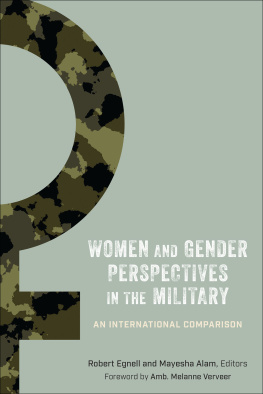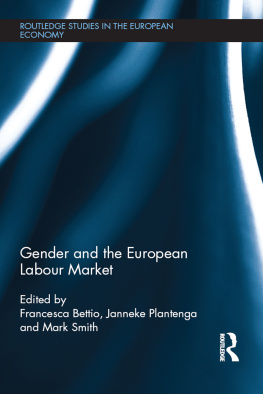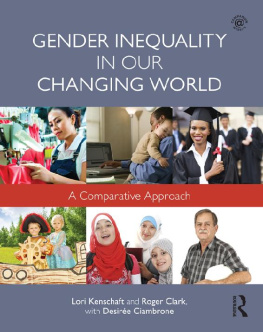GENDER SEGREGATION
Gender Segregation
Divisions of Work in Post-Industrial Welfare States
Edited by
Lena Gons and Jan CH Karlsson
Karlstad University, Sweden
First published 2006
by Ashgate Publishing
Published 2016
by Routledge
2 Park Square, Milton Park, Abingdon, Oxon OX14 4RN
711 Third Avenue, New York, NY 10017, USA
Routledge is an imprint of the Taylor & Francis Group, an informa business
Copyright 2006 Lena Gons and Jan Ch Karlsson
Lena Gons and Jan Ch Karlsson have asserted their moral right under the Copyright, Designs and Patents Act, 1988, to be identified as editors of this work.
All rights reserved. No part of this book may be reprinted or reproduced or utilised in any form or by any electronic, mechanical, or other means, now known or hereafter invented, including photocopying and recording, or in any information storage or retrieval system, without permission in writing from the publishers.
Notice:
Product or corporate names may be trademarks or registered trademarks, and are used only for identification and explanation without intent to infringe.
British Library Cataloguing in Publication Data
Gender segregation: divisions of work in post-industrial
welfare states
1.Sexual division of labor 2.Women employees 3.Employee
rights 4.Sexual division of labor - Sweden 5.Women
employees - Sweden 6.Employee rights - Sweden
I.Gonas, Lena, 1945- II.Karlsson, Jan, 1948
306.3'615
Library of Congress Cataloging-in-Publication Data
Gender segregation: divisions of work in post-industrial welfare states / edited by
Lena Gons and Jan Ch Karlsson.
p. cm.
Includes index.
ISBN 0-7546-4453-7
1. Sexual division of labor--Europe--Case studies. 2. Sexual division of labor-
United States. I. Gons, Lena, 1945- II. Karlsson, Jan, 1948
HD6060.65.E85G455 2005
306.3'615094--dc22
2005030367
ISBN 9780754644538 (hbk)
ISBN 9781138251069 (pbk)
Transfered to Digital Printing in 2012
Contents
- 1. Divisions of Gender and Work
Lena Gons and Jan Ch Karlsson - 2. Labour Market Inequality, Past and Future: A Perspective from the United States
Chris Tilly - 3. Gendered Divisions of Work: A Multilevel Approach
Lena Gons - 4. Segregated Integration
Ann Bergman - 5. Measuring Gender Segregation
Ruth Emerek - 6. The New Economy and the Work Life Balance: Conceptual Explorations and a Case Study of New Media
Diane Perrons - 7. Life Modes and Gender in the Swedish Public-Health Sector
Liselotte Jakobsen - 8. Employment, Flexible Working and the Family
Rosemary Crompton - 9. Men's Parental Leave: A Manifestation of Gender Equality or Child-orientation?
Lisbeth Bekkengen - 10. Dualities and Contradictions
Lena Gons and Jan Ch Karlsson
Lisbeth Bekkengen is a Researcher and has a PhD in Working Life Science from the University of Karlstad, Sweden.
Ann Bergman is a Senior Lecturer and has a PhD in Working Life Science at the University of Karlstad, Sweden.
Rosemary Crompton is Professor of Sociology at the City University London, UK.
Ruth Emerek is Associate Professor at the Institute for History, International and Social Studies at Aalborg University Centre.
Lena Gons is Professor in Working Life Science at the University of Karlstad, Sweden.
Liselotte Jakobsen is Associate Professor in Sociology at the University of Karlstad, Sweden.
Jan Ch. Karlsson is Professor of Sociology at the University of Karlstad.
Diane Perrons is Reader in Economic Geography and Gender Studies and Director of the Gender Group at London School of Economics, UK.
Chris Tilly is Professor at the Department of Regional Economic and Social Development, University of Massachusetts Lowell, USA.
Gender segregation in the labour market has been studied by researchers from different disciplines for decades. Studies have been performed on the labour market level and in work organizations. Also individual outcomes in relation to wages, working contracts and working conditions have been in focus as well as health effects.
The objective with this book is to give a picture of the contemporary social science research in the field and with an international comparative perspective. A background to work is to be found in the research and development project Gender and Work that was launched at the National Institute for Working Life in Stockholm, Sweden in 1999. It was a project uniting research and more practical development work on work place level based on a multidisciplinary approach. A specific task was to study relations between segregation and health.
The project group Gender and Work arranged the third international congress on Women, Work and Health held in Stockholm in June 2002. At the congress two symposia were arranged in cooperation with researchers from the department of Working Life Science at the University of Karlstad. One seminar was arranged by professor Lena Gons and the other by professor Jan Ch Karlsson at the University of Karlstad. This book contains papers from these symposia.
Lena Gons
Jan Ch Karlsson
, The New Economy and the Work Life Balance: Conceptual Explorations and a Case Study of New Media, by Diane Perrons. Published in Gender, Work and Organisations , 2003, vol. 10, no. 1, pp. 6593.
, Employment, Flexible Working and the Family, by Rosemary Crompton. Published in British Journal of Sociology , 2002, vol. 53, no. 4, pp. 537558.
We gratefully acknowledge the permission from the publishers to include these articles in our book.
Chapter 1
Divisions of Gender and Work
Lena Gons and Jan Ch Karlsson
Introduction
The objective of this book is to discuss if and to what extent gender divisions in working life are changing. In doing so, we will explore implications of gender segregation and possible openings for integration at different levels in society. Gender segregation is discussed from two perspectives; a labour market perspective and a family-work level perspective. The authors unite these perspectives and discuss if and where we can find patterns of gender integration and where there still is stability and continuity in gender relations. By applying a multidisciplinary approach and illustrating our problem area with development on different analytical levels we hope to further the discussion on how and in what ways integration can be pursued.
Stability and change
In a long perspective the segregation patterns have changed towards a more even distribution of women and men over occupations and sectors in the labour market in most countries (Rubery et al., 1999). At the same time, countries with high female employment rates have high segregation levels. Studies on the development in the European Union show that there is a positive correlation between employment rates and segregation levels (Rubery et al., 1999; Emerek et al., 2001). As more women enter the labour market they are recruited into sectors and work tasks that already are defined as female jobs, and they are doing service jobs earlier performed in the household but now transformed into market work. Growing welfare state labour markets produce health, education and services and have become major employers of women. The dual dependency between the post industrial welfare state and the growing female labour force has formed new relations in the labour market and in the political arena. Women are dependent on the welfare state for the supply of child and elderly care to be able to take a job at the same time as these services are their major labour market, at least in the Nordic welfare states. In other welfare state regimes the relations are different, and as can be seen from many studies, the support from the state to develop a social infrastructure that support womens paid employment varies (Lewis, 1993; orloff, 1993; Plantenga and Hansen, 1999a and b; Sainsbury, 1999). The retrenchment of the welfare state during the crises of the 1990s had gendered consequences. Plantenga and Hansen cited the Spanish expert in a benchmarking report from the EU network Gender and Employment:







